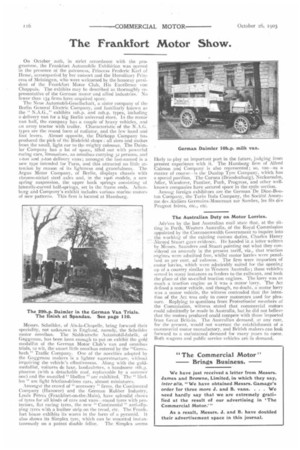The Frankfort Motor Show.
Page 12

If you've noticed an error in this article please click here to report it so we can fix it.
On October 20th, in strict accordance with the programme, the Frankfort. Automobile Exhibition was opened in the presence of the patroness, Princess Frederic Karl of Hesse, accompanied by her consort and the Hereditary Princess of Meiningen, who were welcomed by the honoray president of the Frankfort Motor Club, His Excellence von Chappuia. The exhibits may be described as thoroughly representative of the German motor and allied industries. No fewer than 154 firms have acquired space.
The Neue Automobil-Gesellschaft, a sister company of the Berlin General Electric Company, and familiarly known as the " N.A.G.," exhibits toh.p. and 2oh.p. types, including a delivery van for a big Berlin universal store. In the motor van hall, the company has a couple of heavy vehicles, and an army tractor with trailer. Characteristic of the N..A.G. types are the round form of radiator, and the few hand and foot levers. Almost opposite, the Diarkopp Company has produced the pick of the Bielefeld shops all sizes and makes from the small, light car to the mighty colossus. The Daimler Company has a lot of space, filled out with powerful racing cars, limousines, an omnibus carrying 32 persons, and t-ton and 2-ton delivery vans; amongst the last-named is a new type intended for Paris, and this attracted no little attention by reason of its lightness and gracefulness. The Argus Motor Company, of Berlin, displays chassis with chronic-nickel steel axles and, in the 1906 models, a new spring suspension, the upper back springs consisting ol laterally-curved half-s-ings, set in the frame ends. Achenburg and Company's exhibit includes various marine motors of new patterns. This firm is located at Hamburg.
Messrs. Scheibler, of Aix-la-Chapelle, bring forward their speciality, not unknown in England, namely, the Scheibler motor omnibus. The Saddeutsche Autornobil-fabrik, of Gagg-enau, has been keen enough to put on exhibit the gold medallist of the German Motor Club's van and omnibus trials, to wit, the smart little omnibus entered by the "Gentsback " Traffic Company. One of the novelties adopted by the Gaggenau makers is a lighter superstructure, without impairing the vehicle's effectiveness. Along with the goldmedallist, voitures de luxe, landaulettes, a handsome t6h.p. phaeton (with a detachable roof, replaceable by a summer one) and the so-called " libellen " are exhibited. The " libellen " are light friction-driven cars, almost miniatures.
Amongst the crowd of " accessory " firms, the Continental Company (Hanover) and the German Rubber Industry, Louis Peters (Frankfort-on-the-Main), have splendid shows of tyres for all kinds of cars and vans--round tyres with protectors, fiat racing tyres, the new " Continental " anti-slipping tyres with a leather strip on the tread, etc. The Frankfort house exhibits its wares in the form of a pyramid. It also shows its Simplex tyre, which can he mounted instan taneously on a patent double felloe. The Simplex seems likely to play an important part in the future, judging from present experience with it. The Hamburg firm of Alfred Calmon and Company is also represented; so, too--as a matter of course—is the Dunlop Tyre Company, which has a special pavilion. The Corona (Brandenburg), Neckarsulm, Adler, Wanderer, Panther, Puch, Progress, and other wellknown companies have secured space in the cycle station.
Amongforeign exhibitors are the German De Dion-Bouton Company, the Turin Itala Company, the Societe Anonyme des Ateliers Germains-Monceaux sur Sambre, les fits des Peugeot fret-es, etc., etc.
The Australian Duty on Motor Lorries.
Advices by the last Australian mail state that, at the sitting in Perth, Western Australia, of the Royal Commission appointed by the Commonwealth Government to inquire into the working of the existing custom duties, Charles Henry Akroyd Stuart gave evidence. He handed in a letter written by Messrs. Saunders and Stuart pointing out what they considered an anomaly in the present tariff, viz., that traction engines were admitted free, whilst motor lorries were penalised 20 per cent, ad valorem. The firm were importers of motor lorries, which were admirably suited for the openingup of a country similar to Western Australia; these vehicles served in many instances as feeders to the railways, and took the place of the so-called traction engines. The lorry was as much a traction engine as it was a motor lorry. The Act defined a motor vehicle, and though, no doubt, a motor lorry was a motor vehicle, the witness contended that the intention of the Act was only to cover motorcars used for pleasure. Replying to questions from Protectionist members of the Commission, witness stated that commercial mdtors could admittedly be made in Australia, but he did not believe that the motors produced could compete with those imported front Great Britain. The Australian demand, at any rate, for the present, would not warrant the establishment of a commercial motor manufactory, and British makers can look forward to a maintained demand for nanny Years to come. Both wagons and public service vehicles are in demand.




















